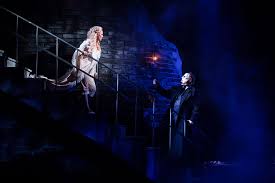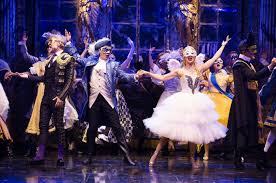  
The crimson velvet curtain ascended for the first time on June 10th, 2025, marking the triumphant opening night of Andrew Lloyd Webber's immortal masterpiece at ROMEXPO's Central Pavilion, where the very air seemed to shimmer with the collective breath of three thousand souls held captive by the most haunting love story ever conceived for the musical stage. This magnificent production, part of an international tour that has already conquered the hearts of audiences across continents, arrived in Bucharest with all the grandeur and mystique that has made The Phantom of the Opera the longest-running show in Broadway history, having surpassed even CATS with its 7,486th performance back in 2006.
The Genesis of an Eternal Obsession
Born from the fevered imagination of Gaston Leroux in his 1910 novel "Le Fantôme de L'Opéra," this tale of obsessive love and artistic genius found its most sublime expression through Andrew Lloyd Webber's compositional brilliance. The musical's journey from its West End premiere at Her Majesty's Theatre on October 9, 1986, to its Broadway debut at the Majestic Theatre on January 26, 1988, represents nothing less than the evolution of theatrical storytelling itself. Over the decades, this production has metamorphosed from a groundbreaking spectacle into a living, breathing entity that continues to reinvent itself while maintaining the core elements that have captivated over 160 million people across 195 cities in 21 languages.
The Bucharest engagement, comprising eight sold-out performances from June 10-15, stands as a testament to the enduring power of this theatrical phenomenon. Each evening performance, commencing at precisely 8:00 PM, unfolds across two acts-the first spanning one hour and twenty minutes of pure enchantment, followed by a twenty-minute intermission that allows audiences to process the emotional tsunami they've just experienced, before the fifty-five-minute second act delivers its devastating conclusion.
The Cathedral of Dreams Awakens
As the house lights dimmed on that magical Tuesday evening, the ROMEXPO Central Pavilion transformed into something far beyond a mere performance venue-it became a cathedral of dreams where reality surrendered to the sublime. The production's legendary chandelier, that magnificent crystal behemoth weighing nearly a ton, hung suspended above the audience like a glittering sword of Damocles, its thousands of crystals catching and fracturing the stage lights into a constellation of earthbound stars.
The opening auction scene materialized with the precision of a master clockmaker's creation, as the aged Raoul, portrayed with heartbreaking dignity by Dougie Carter, stood among the detritus of the Paris Opera House's forgotten glory. The auctioneer's voice echoed through the pavilion as Lot 666 - a music box featuring a monkey in Persian robes-was presented to the assembled bidders, but it was the appearance of the chandelier that sent electric anticipation coursing through every soul present.
The Descent into Magnificence
When the chandelier began its majestic ascent, accompanied by the thunderous opening chords of the overture, time itself seemed to bend and warp around the audience. The transformation from the dusty auction house to the opulent 1881 Paris Opera House occurred with such seamless artistry that one could almost smell the gaslight and hear the rustle of silk gowns in the boxes above.
Nadim Naaman's Phantom emerged from the shadows like a force of nature given human form, his presence both terrifying and magnetic. The Lebanese-British actor, whose fifteen-year journey with this production has seen him evolve from ensemble member to the titular role, commanded the stage with an authority that seemed to emanate from the very depths of the opera house's foundations. His voice, when it finally soared through "The Music of the Night," possessed a quality that transcended mere performance-it became a summoning, a dark prayer that called forth every secret desire lurking in the human heart.
The Angels and Demons of Song
Georgia Wilkinson's Christine Daaé materialized as if conjured from moonbeams and starlight, her voice carrying the crystalline purity that has made "Think of Me" one of musical theater's most beloved arias. When she first appeared in the opera house's rehearsal, replacing the tempestuous Carlotta, her transformation from chorus girl to prima donna unfolded with the inevitability of a fairy tale, yet grounded in the very real struggle of an artist discovering her true voice.
Lara Martins brought six years of London West End experience to her portrayal of Carlotta Giudicelli, the opera's reigning diva whose volcanic temperament and wounded pride created a perfect storm of dramatic tension. Her costume changes-from the elaborate gowns of "Hannibal" to the sumptuous creations for "Il Muto"-represented a masterclass in period authenticity, each garment telling its own story of vanity, ambition, and the desperate need for artistic validation.
The love triangle's third point, Dougie Carter's Raoul, embodied the tragic nobility of a man whose conventional love could never compete with the Phantom's obsessive devotion. His duets with Christine, particularly "All I Ask of You," resonated with the bittersweet knowledge that pure love, however genuine, sometimes proves insufficient against the darker forces of passion and possession.
The Architecture of Wonder
The production's scenic design revealed itself as a character unto itself, with Gary McCann's sets creating a labyrinthine world where reality and nightmare intertwined. The famous staircase, descending into the Phantom's lair, seemed to spiral not just into the depths of the opera house but into the very unconscious mind itself. Each step Christine took downward represented another layer of psychological descent, another barrier between the world of light and the realm of shadows.
The boat scene, where the Phantom guides Christine through the underground lake, achieved a level of theatrical magic that defied rational explanation. The mist rising from the water, the flickering candles emerging from the darkness, and the gradual revelation of the Phantom's lair created an atmosphere so thick with romance and menace that the audience seemed to hold its collective breath, afraid that any sound might shatter the spell.
The Masquerade of Souls
The second act's "Masquerade" sequence exploded across the stage like a fever dream of color and movement, with over 230 costumes creating a kaleidoscope of 19th-century excess. The ensemble, comprising 100 members of cast, crew, and orchestra, moved with the precision of a Swiss timepiece, each performer contributing to a tableau that seemed to capture the very essence of decadent European society. The Phantom's appearance as the Red Death, descending the grand staircase in his scarlet cape and skull mask, sent visible shivers through the audience-a moment of pure theatrical terror that reminded everyone present why this story has endured for over a century.
The Final Descent
As the production hurtled toward its inevitable conclusion, the emotional intensity reached levels that bordered on the unbearable. The Phantom's lair, now revealed in all its gothic splendor, became the setting for the final confrontation between love and obsession, between the light of conventional morality and the darkness of artistic genius unbound by societal constraints.
Naaman's final moments as the Phantom-his voice breaking with genuine anguish as he released Christine to her chosen life-achieved a level of emotional authenticity that transformed the character from monster to tragic hero. When he vanished into the shadows, leaving only his mask behind, the silence that followed seemed to stretch into eternity, broken finally by an eruption of applause that shook the very foundations of the pavilion.
A Legacy Written in Light and Shadow
This Bucharest engagement of The Phantom of the Opera stands as more than mere entertainment-it represents the continuation of a theatrical tradition that connects us to the deepest wells of human emotion and artistic expression. The production's ability to sell out all eight performances in a city hungry for world-class musical theater speaks to the universal appeal of this timeless story.
As the final curtain fell and the cast took their bows, bathed in the golden glow of the restored chandelier, one could not help but feel that something sacred had transpired within those walls. The Phantom of the Opera had once again proven that great art transcends time, language, and cultural boundaries, speaking directly to the eternal human need for beauty, passion, and the transformative power of music itself.
In the pantheon of musical theater, this production claims its rightful place among the stars-not merely as entertainment, but as a testament to the enduring power of the human spirit to create beauty from darkness, to find love in the most unlikely places, and to remind us all that somewhere, in the shadows of our own hearts, a phantom waits to be acknowledged, understood, and perhaps even loved. |










